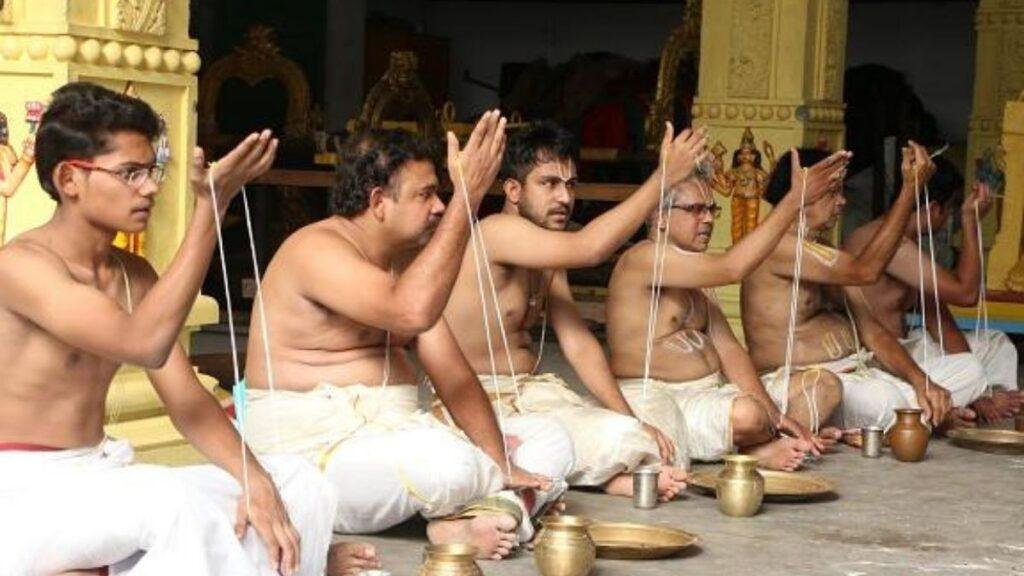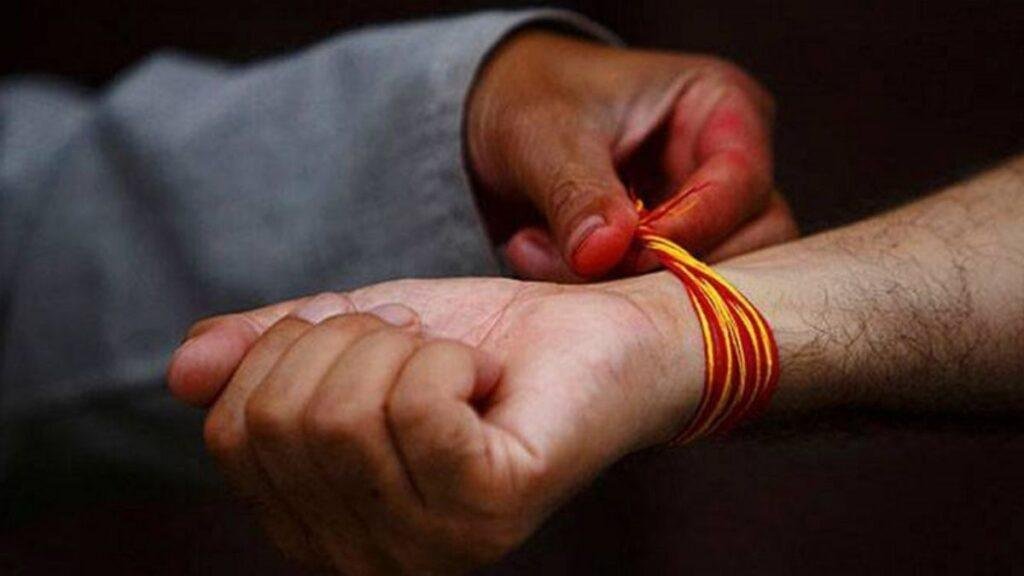
हिंदू पवित्र धागा पहनने की मान्यताएं और लाभ
Hinduism is a religion that has numerous ways to rid of all negative and accidents. If you follow the rules completely with your whole heart, and determination surely, you will see positive outcomes. In addition to these techniques and rituals that use threads, the different body parts can also have significance of their own.
हिंदू धर्म एक ऐसा धर्म है जिसमें सभी नकारात्मक और दुर्घटनाओं से छुटकारा पाने के कई तरीके हैं। यदि आप पूरे मन और दृढ़ संकल्प के साथ नियमों का पूरी तरह से पालन करते हैं, तो आपको सकारात्मक परिणाम दिखाई देंगे। धागों का उपयोग करने वाली इन तकनीकों और अनुष्ठानों के अलावा, शरीर के विभिन्न अंगों का भी अपना महत्व हो सकता है।
You've probably seen quite an amount of Hindu worshippers wearing various threads. Different colours such as orange, red, white as well as black and yellow are available in the sacred threads. The threads are not all able to be worn by anybody or for any reason. They each have their own distinct motivations for individuals.
आपने शायद काफी संख्या में हिंदू उपासकों को विभिन्न धागे पहने हुए देखा होगा। पवित्र धागों में नारंगी, लाल, सफेद और साथ ही काले और पीले जैसे विभिन्न रंग उपलब्ध हैं। सभी धागे किसी के द्वारा या किसी भी कारण से पहनने में सक्षम नहीं होते हैं। उनमें से प्रत्येक की अपनी अलग प्रेरणाएँ और व्यक्ति हैं।
We now need to understand the significance of these threads.
अब हमें इन धागों के महत्व को समझने की जरूरत है।
White Thread (Janeu)

The particular thread is only worn by males of the families with higher castes. It represents the transformation of an infant boy into becoming a man. Brahmins have male members wear the sari by conducting an event known as the sacred "Thread Ceremony'. Certain Kshatriyas and Vaishyas are also wearing it. The sacred thread of Brahmins is made from cotton, the threads of the Kshatriya composed of hempen threads, and the one of the Vaisya with woollen threads.
Significance It depicts the change of a child into manhood. Brahmins require male members to wear the thread by performing an event called the sacred 'Thread Ceremony'.
विशेष धागा केवल उच्च जाति वाले परिवारों के पुरुषों द्वारा पहना जाता है। यह एक शिशु लड़के के पुरुष बनने में परिवर्तन का प्रतिनिधित्व करता है। ब्राह्मणों के पुरुष सदस्य एक पवित्र "धागा समारोह' के रूप में जाना जाने वाला एक कार्यक्रम आयोजित करके साड़ी पहनते हैं। कुछ क्षत्रिय और वैश्य भी इसे पहनते हैं। ब्राह्मणों का पवित्र धागा कपास से बना होता है, क्षत्रिय के धागे भांग के धागों से बने होते हैं, और ऊनी धागों वाला वैश्य।
महत्व: इसमें एक बच्चे के वयस्क में परिवर्तन को दर्शाया गया है। ब्राह्मणों को पवित्र 'धागा समारोह' नामक एक कार्यक्रम करके पुरुष सदस्यों को धागा पहनने की आवश्यकता होती है।
Red Thread (Kalava)

Threads of red are extremely popular for Hindus. Women and men as well as women are able to wear it by performing a simple puja. The red thread is generally worn to the hands of males and women who are not married, whereas it is placed on the left hand of married women. It is available in every temple. It's a cotton thread that was initially given as an offering to the god.
The day that falls on Bhadrapad Shukl Chaturdashi or Anant Chaturdashi wearing a red thread, also known as 'Anant Choudas Thread is thought to be extremely lucky. It can be worn as a wristband or tied around the neck by females and men. Wearing it will bring happiness well-being, health, and wealth.
Significance The red thread, or Kalava signifies longevity and protection from enemies. Therefore, it is known as the 'Raksha thread'. According to some, wearing it will ensure that God's blessings are with you.
लाल रंग के धागे हिंदुओं के लिए बेहद लोकप्रिय हैं। महिलाएं और पुरुष के साथ-साथ महिलाएं इसे एक साधारण पूजा करके भी पहन सकती हैं। लाल धागा आमतौर पर उन पुरुषों और महिलाओं के हाथों में पहना जाता है जिनकी शादी नहीं हुई है, जबकि इसे विवाहित महिलाओं के बाएं हाथ में रखा जाता है। यह हर मंदिर में उपलब्ध है। यह एक सूती धागा है जिसे शुरू में भगवान को प्रसाद के रूप में दिया जाता था।
वह दिन जो भाद्रपद शुक्ल चतुर्दशी या अनंत चतुर्दशी को लाल धागा पहनकर आता है, जिसे 'अनंत चौदस धागा' भी कहा जाता है, अत्यंत भाग्यशाली माना जाता है। इसे महिलाओं और पुरुषों द्वारा रिस्टबैंड के रूप में पहना जा सकता है या गले में बांधा जा सकता है। इसे धारण करने से सुख-समृद्धि, स्वास्थ्य और धन की प्राप्ति होती है।
महत्व: लाल धागा, या कलावा दीर्घायु और शत्रुओं से सुरक्षा का प्रतीक है। इसलिए, इसे 'रक्षा धागा' के रूप में जाना जाता है। कुछ के अनुसार, इसे पहनने से यह सुनिश्चित होगा कि भगवान का आशीर्वाद आपके साथ है।
Black Thread

Another important thread used by Hindus. When it comes to young children, it's typically tied around their waists and adults wear it on their left wrists or armlets. Some tie a specific root to it and wear it as necklaces. Those who practice black magic/Tantric Vidhya could wear it on their right foot, too.
Significance it is believed to shield children from evil eyes (Buri Nazar). It also protects individuals from evil spirits or unwelcome tantra mantras.
हिंदुओं द्वारा इस्तेमाल किया जाने वाला एक और महत्वपूर्ण धागा। जब छोटे बच्चों की बात आती है, तो यह आमतौर पर उनकी कमर के चारों ओर बंधा होता है और वयस्क इसे अपनी बाईं कलाई या बाजू में पहनते हैं। कुछ लोग इसकी एक खास जड़ बांधते हैं और इसे हार के रूप में पहनते हैं। जो लोग काला जादू/तांत्रिक विद्या का अभ्यास करते हैं, वे इसे अपने दाहिने पैर में भी पहन सकते हैं।
महत्व: ऐसा माना जाता है कि यह बच्चों को बुरी नजर (बुरी नजर) से बचाता है। यह व्यक्तियों को बुरी आत्माओं या अवांछित तंत्र मंत्रों से भी बचाता है।
Orange Or Saffron Thread

Threads of orange are very common in both east and south India. The wearers of the thread have various reasons. It's a long string that is wrapped around your wrist several times, forming the shape of a bundle.
Significance: The significance of the Orange thread is to be a source of fame, power, and protection against every negative influence.
नारंगी के धागे पूर्व और दक्षिण भारत दोनों में बहुत आम हैं। धागा पहनने वालों के कई कारण होते हैं। यह एक लंबी डोरी है जो आपकी कलाई के चारों ओर कई बार लपेटी जाती है, जिससे एक बंडल का आकार बनता है।
महत्व: नारंगी धागे का महत्व हर नकारात्मक प्रभाव से प्रसिद्धि, शक्ति और सुरक्षा का स्रोत होना है।
Yellow Thread

Yellow is a colour that represents pureness and good health. The people believe that this colour can be essential in important events like marriages and opening ceremonies. Hindus use haldi to make thick cotton threads and utilize it to symbolize good luck when they marry. The bride is required to wear it in three knots that are tied around her neck or on her armlet.
Significance: It is believed to make marriage prosperous and happy. Also, it ensures the longevity of the groom.
पीला एक ऐसा रंग है जो शुद्धता और अच्छे स्वास्थ्य का प्रतिनिधित्व करता है। लोगों का मानना है कि विवाह और उद्घाटन समारोह जैसे महत्वपूर्ण आयोजनों में यह रंग आवश्यक हो सकता है। हिंदू मोटे सूती धागे बनाने के लिए हल्दी का उपयोग करते हैं और शादी के समय इसका उपयोग सौभाग्य के प्रतीक के रूप में करते हैं। दुल्हन को इसे तीन गांठों में पहनना होता है जो उसके गले में या उसके बाजू में बंधी होती हैं।
महत्व: ऐसा माना जाता है कि यह विवाह को समृद्ध और खुशहाल बनाता है। साथ ही यह दूल्हे की लंबी उम्र भी सुनिश्चित करता है।
